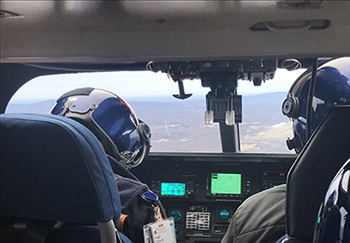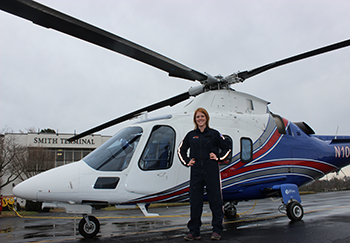
UVA’s medical helicopter, called Pegasus, is a Charlottesville legend. Even as a kid growing up in Charlottesville, I knew about the important emergency rescue work the Pegasus team did, and I would get excited every time I saw it flying around town. I had no idea what a typical day looked like for the medevac flight team, though, so I was pretty thrilled by the opportunity to shadow the team for a day earlier this year.
The primary Pegasus helicopter, the one with the winged horse on the side, was out of service for scheduled maintenance when I did my ride-along. The secondary helicopter is nearly identical, just without the same markings on the outside. The morning of my ride-along was a very cloudy one. We wouldn’t be able to fly until visibility improved. I met the day’s crew as soon as I arrived: pilot Kim Welliver, nurse Shawn Reid and paramedic Hugh Cline. They taught me a lot about the Pegasus team and the patients they transport while we were waiting on the weather to clear.
Who Pegasus Transports
Pegasus cares for patients of all ages, from premature babies to elderly. Weather conditions, the type and severity of accident or illness and proximity to specialized care all factor in to whether the patient is transported by ground ambulance or by medevac flight.
Pegasus Team Quick Facts
- On average, they respond to one call for a flight in a 24-hour period.
- Their goal is to lift off within 7 minutes of receiving a call, and to lift off from a scene with a patient within 10 minutes of arriving on scene.
- The crew accepts calls up to 160 nautical miles away.
- There is also a Pegasus ground crew. The same group of paramedics and nurses run both the ground and flight teams.
There are three main flight scenarios:
- From the field: Pegasus travels to the scene of an emergency and brings the injured or ill person back to UVA for treatment.
- Hospital-to-hospital: the Pegasus team picks up a patient from another hospital and brings them to UVA for specialized treatment. This can include bringing premature newborns that are born in a hospital without a NICU (neonatal intensive care unit) to UVA’s NICU.
- Triangle flight: the team picks up a patient from the scene, and based on hospital bed availability, location and type of care required, takes the patient to a hospital other than UVA. Then Pegasus returns to Charlottesville.
Medical Helicopter Safety
The Pegasus team means it when they say “safety first.” Every member of the crew has to agree to a call before the team goes on the call. If any member has a safety concern due to weather, location, etc., the team doesn’t go. It’s a policy they refer to as “three to go, one to no.”
About the Medevac Helicopter
- The helicopter is an Agusta 109.
- The fuel tank holds 159.8 gallons.
- The maximum capacity is four flight crew and a patient.
- Max flight time before refueling is 2 hours and 10 minutes.
- All flying controls are duplicated on both sides of the cockpit.
- The landing gear isn’t fixed. Unlike some helicopters that have metal skids and can only take off and land vertically, this helicopter has landing gear that retracts much like an airplane. It can do vertical or rolling takeoffs and landings.
The team doesn’t even know the patient’s age or situation until they are airborne. This is so the team won’t make risky choices about flying because, for example, they know the patient is a child. The only exception to this rule is premature newborns since the team has to load a 250-pound incubator prior to these flights.
Just before takeoff, the nurse or paramedic recites a pre-flight checklist, which the pilot confirms. After that, “sterile cockpit time” begins. During these few minutes surrounding liftoff, everyone in the helicopter should be paying attention and looking around outside the aircraft for potential hazards.
The helicopter is outfitted with a radio system and a satellite phone for communication, and the team has ongoing contingency training for equipment failure.
Training for Critical Care Transport
There is a nurse and a paramedic on every Pegasus flight. Team members typically have extensive experience prior to working with Pegasus. They also have additional certifications that allow them to administer drugs on-scene and in-flight that a typical EMT cannot. Being able to administer these drugs before a patient even reaches the hospital can dramatically increase the patient’s chance of survival.
Medevac Flight Technology
The Pegasus helicopter and ground teams are basically extensions of the hospital’s emergency department and intensive care unit. Because of their extensive training, the crews can put a patient to sleep or on a ventilator, administer a wide variety of drugs and place chest tube and central lines (similar to an arm or hand IV, but placed in the chest, and allow multiple drugs to be administered at once).
They even have drugs that some small community hospitals don’t have — for example surfactant, for premature newborn lungs.

Some of the on-board medical technology includes:
- Ultrasound — helps with placing central or arterial lines to administer drugs, also lets them look at heart function to see what drugs to give
- IV pumps — preloaded with medications the flight crew can administer
- State-of-the-art heart monitor — identifies and corrects abnormal heart rhythms
- Ventilator — administers CPAP and BiPAP (breathing for patients who cannot breathe for themselves)
- i-STAT — handheld blood analyzer, which helps guide treatment
The Helicopter Flight
The skies cleared early in the afternoon, and we could start receiving calls at that point. By late afternoon, we hadn’t received a call, so we went on a training flight instead. The crew packed up the helicopter (refrigerated drugs, blood for transfusions, etc.) just as if this was a normal call. That also meant we would be able to respond to a real call if one came in while we were out.
We all wore helmets in flight, which are wired with headsets so we could speak to one another. Once we were all buckled, flight nurse Shawn Reid recited the pre-flight checklist, and pilot Kim Welliver confirmed each item. After that, “sterile cockpit time” began.

The helicopter vibrates a bit during its climb, but after that, it’s a surprisingly smooth ride. After takeoff, we headed north to the Ruckersville Rescue Squad, where we landed in a field behind the station. We touched down briefly, repeated the same pre-flight routine, and then were airborne again. This time we flew to UVA Medical Center, where we landed on the helipad on the roof, just as we would have if we were arriving with a patient.
We even got to test a pre-programmed auto-pilot route on our approach to the hospital. These routes are referred to as IFR (instrument flight rules) approaches and they are a safety feature that allows the aircraft to safely reach a destination even if visibility becomes poor.
An outside consultant creates each IFR approach. The FAA (Federal Aviation Administration) must approve the approach before medevac crews can use it. Pegasus has pre-programmed IFR approaches for seven of their most commonly traveled routes. If weather changes unexpectedly along another route, the crew can wait out the weather from the ground.
After repeating the same pre-flight procedure, we headed back to the airport and landed there. The crew unloaded the supplies they’d brought on board and went back to waiting for the next call to come in. They explained that there’s lots of downtime, and that gives them time to work on ongoing training. It also gives them a chance to relax and joke around – often a much-needed break from the tough stuff they see.
Subscribe for More Stories Like This
Sign up to have interesting stories and health tips delivered to your inbox each week.
The Best Part of the Job
Emergency rescue teams have a tough job. They have to be ready to go at a moment’s notice. They don’t always get the outcomes they want, and they see some things that are hard to even imagine.
The good tends to outweigh the bad, though. As Hugh Cline explained, “When it’s game on, it’s game on, and you never know what you’re going to get. It’s exciting and it’s challenging. This is the top echelon of what a paramedic can do in his career.”
Shawn Reid agreed, saying, “it’s the best job in the world because you get to make a difference every time you go out.”


Little tidbit on history of Pegasus. An employed contest was held to name the air transport of the UVA medical center The contest was won by Ruth (Frankie) Hooper who submitted the name “Pegasus”.